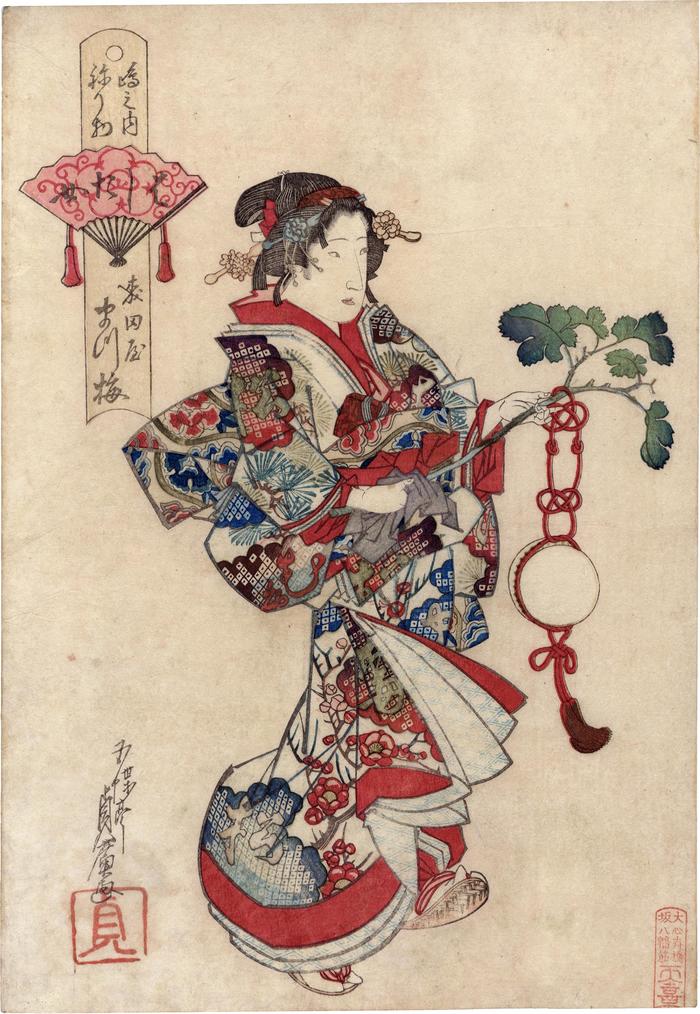Utagawa Sadahiro (歌川貞広) (artist )
Matsuume (まつ梅) of the Moritaya (森田屋) as a Palace Maid (Hashitame - はした女) from the series Costume Parade of the Shimanouchi Quarter (Shimanouchi nerimono - 島之内ねり物)
06/1836
10 in x 14.5 in (Overall dimensions) Japanese color woodblock print
Signed: Gochōtei Sadahiro ga
五蝶亭貞広画
Artist's seal: 'Sada'
Publisher: Tenmaya Kihei (Marks 536- seal 24-035)
Museum of Fine Arts, Boston
Hankyu Culture Foundation
Royal Museums of Art and History, Belgium (via Cultural Japan)
Philadelphia Museum of Art
Lyon Collection - another print from this series
Philadelphia Museum of Art - two related prints by Shigeharu The text in the upper left reads: 嶋の内 ねり物 はした女 中東新 まつ梅
In 1836 two publishers, Tenmaya Kihei and Honya Seishichi, got together with a group of artists, Hokuei, Shigeharu, Sadanobu, Hokuju and Sadahiro, to produce a series of 12 prints celebrating an annual festival in the Osaka Shimanouchi pleasure district. Each print shows a geisha in an elaborate costume. The title cartouche gives the name of the series, while the fan motif describes her costume and below that is the name of the woman posed and the establishment she worked for.
****
In The Theatrical World of Osaka Prints it says on pages 148-149: "The official, government-controlled brothel district of Osaka was Shinmachi, but thirty or more smaller entertainment districts were scattered among the outskirts of the city in Horie, Tenma, Kitanoshinchi, Shimanouchi, and elsewhere. Shimanouchi was located just north of the Dōtonbori Canal from the theater district, and was the largest unofficial gay quarter in Osaka. One of the annual events of Shimanouchi was a parade each June with courtesans and geisha in masquerade. The parades were banned for some time, but resumed in the summer of 1819, and were made up of large floats carrying musicians and dancers. Festival programs [sairei banzuke] were issued to let people know the order of the floats and what each represented. The earliest Osaka prints of the subject were designed by Yanagawa Shigenobu and published around 1822, but Edo Prints, usually of large groups of figures were designed in the 1790s and earlier by Utamaro and others for the Niwaka festival in the Yoshiwara district there."
****
Illustrated:
1) in color in 原色浮世絵大百科事典 (Genshoku Ukiyoe Daihyakka Jiten), vol. 9, p. 118., #294.
2) in color in Osaka Prints by Dean J. Schwaab, Rizzoli, 1989, page 239, #267.
Schwaab wrote: "This composition may be from a triptych that also illustrates a palace night attendant and a gatherer of green herbs, but the connection seems vague. She is carrying a football suspended from a leafy branch. This print is roughly contemporary with Sadahiro's first theatrical and landscape efforts." [Note, the author was wrong about this being from a triptych. It was from a series of 12 prints designed by various artists.]
3) in black and white Hirosada: Ōsaka Printmaker by Roger Keyes, University Art Museum, California State University, Long Beach, 1984, no. 3, page 78. The left-hand panel of a diptych. Keyes dates it to 7/1837. This example comes from the collection of the Philadelphia Museum of Art.
Keyes wrote: ""The major kabuki and puppet theaters in Ōsaka were located in the Ebisu and Nihon Bridges along the south bank of the Doton Canal. Directly across the canal lay the Shimanouchi entertainment district, a congeries of restaurants and teahouses. The district sponsored annual events in which waitresses, geisha and other female entertainers donned elaborate costumes and performed skits or pantomimes. In 1836, the artist Hokuei designed a series of prints of these women in costume. The following year Hirosada designed pictures of two geisha employed by an establishment called Chūskinken (or Nakamoriken). The series title, the name of the woman and her place of employment are written on a cartouche int he shape of a wooden plaque, which supports a gan bearing the name of the woman's role. Matsuume is dressed as a maid (hashitame) carrying a football suspended from a leafy branch: Tora (the second woman to bear this name) carries a basket of freshly picked spring herbs. Sadanobu, Shigeharu and a pupil of Hokuei name Hokuju also contributed designs to the set."
****
In a biography of Hasegawa Sadanobu I OsakaPrints.com identifies this print as being by that artist and not by Sadahiro, as we have it here. However, the Museum of Fine Arts in Boston, the Philadelphia Museum of Art and the Hankyu Culture Foundation all say this print is by Sadahiro. As a point of reference, OsakaPrints.com rarely makes such a mistake and can nearly always be relied upon to provide the correct information.
Tenmaya Kihei (天満屋喜兵衛) (publisher)
Kyōto-Osaka prints (kamigata-e - 上方絵) (genre)
beautiful woman picture (bijin-ga - 美人画) (genre)
